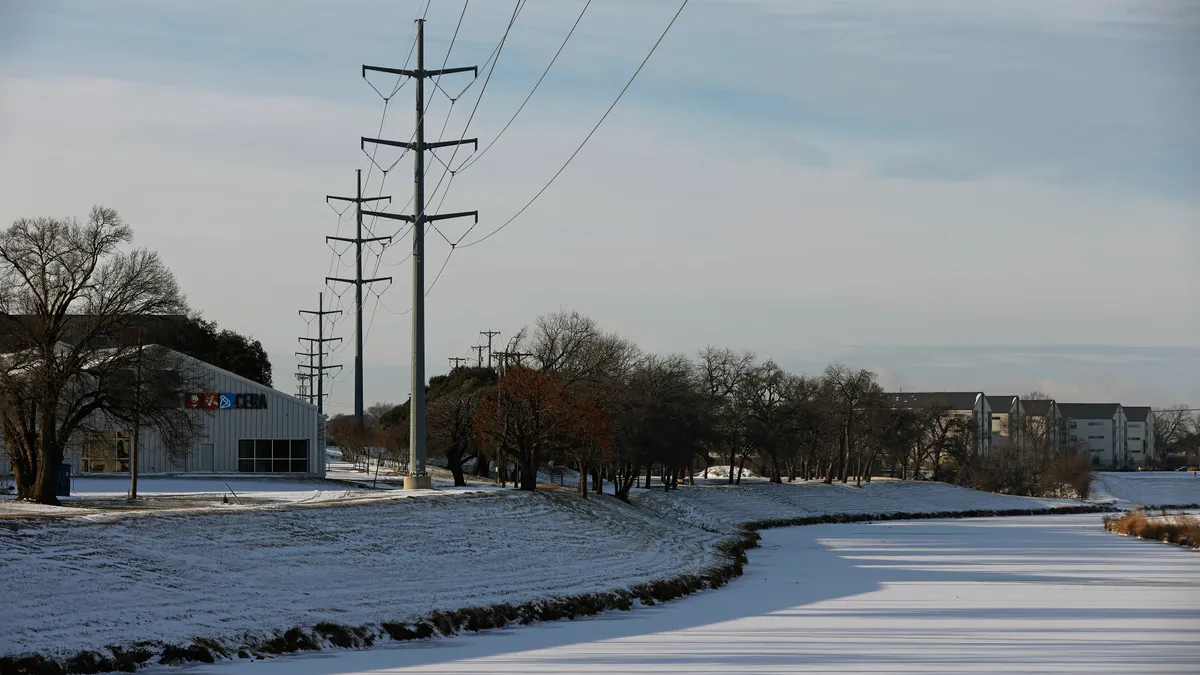Dive Brief:
- The Electric Reliability Council of Texas on Tuesday released a 60-point roadmap outlining how the grid operator plans to ensure the state's power grid is more reliable, following the catastrophic blackouts this winter that almost shut down the region's entire electric system.
- ERCOT's road map is a response to several bills passed by the legislature this year aiming to bolster regional electric reliability, as well as a letter from the governor sent last week that directed the Public Utility Commission of Texas (PUCT) to take "immediate action" to secure grid reliability. Former PUCT officials called the plan "a good start," but said the state still needs to think about how it can improve demand response and energy efficiency programs. They also emphasized the need for a robust evaluation of what caused the February outages.
- A report also released Tuesday from the University of Texas at Austin's Energy Institute begins to answer those questions, finding the outages that plagued Texas last winter were caused by multiple failures across the gas and electric systems, including, in part, fuel shortages, outages at critical fuel facilities and non-weatherized power plants.
Dive Insight:
The Texas legislature in May passed comprehensive legislation intended to overhaul the state's power grid and strengthen reliability. Two of the bills, signed into law by Gov. Greg Abbott, R, in June, will require power companies to weatherize their power plants and transmission lines, and require ERCOT's board to be appointed by state legislators, while also shrinking the grid operator's board of directors from 16 to 11.
Abbott in his letter to ERCOT last week said the laws would "significantly reform Texas' energy and power market," but added that "more can be done to increase power generation capacity and to ensure the reliability of the Texas power grid." He directed the PUCT to streamline incentives for natural gas, coal and nuclear power; allocate reliability costs to more intermittent resources such as wind and solar; establish a maintenance schedule for gas, coal and nuclear; and accelerate development of some transmission projects.
In response to the governor's directive, ERCOT Interim President and CEO Brad Jones sent the 60-point roadmap to the governor, which lays out a number of action items, and the grid operator's progress on those developments. Several of its objectives have been officially proposed, including new market rules to communicate more effectively with customers and generators; perform power plant spot checks ahead of summer, not just winter; and improve assessment of high-impact, low probability weather scenarios; among other strategies.
A coalition of former PUCT officials called the road map "a significant step toward fixing the Texas Electric System," though caveated that it leaves some of the recommendations in the group's June report, outlining how the region's grid operator can avoid a similar disaster, unaddressed.
"The most important opportunities ignored are the need to expand and use energy efficiency and demand response aggressively to improve resource adequacy, create more cushion for grid operations, and protect more customers from future grid failures. And we still need a detailed, credible analysis of the blackout causes before other solutions can be crafted," said Alison Silverstein, a co-author of the report who previously worked at the PUCT and the Federal Energy Regulatory Commission, in an email.
Pat Wood III, another co-author of the report and a former FERC and PUCT chair, said in an email the plan is "robust," but agreed with Silverstein that "the full story" on what happened in February is still needed. The UT paper "was [a] big step forward on that front," he added.
UT's report found the "failure" of the natural gas and electric system during the February winter storm "had no single cause." All generation technologies — gas, coal and nuclear plants, as well as solar and wind facilities — failed in some capacity as a result of the storm. ERCOT's most extreme winter scenario underestimated demand by about 9,600 MW, or 14%, the report found, while weather models inaccurately predicted the timing and severity of the storm.
The report confirmed that the grid came dangerously close to shutting down entirely following a rapid decline in power plant capacity, met with an onset of demand. Power plants came offline for a variety of reasons, UT found, including "weather-related" issues, "equipment issues" and fuel shortages. Several generating units were not weatherized properly, the report found, in part leading to these issues.
Much of the failures can be attributed to the gas industry, according to the report: gas facilities failed to provide enough fuel for power plants, and fuel shortages began days before ERCOT called for blackouts. There were also several critical infrastructure facilities, including those that deliver fuel to power plants, under a voluntary ERCOT program that pays customers so that the grid operator can cut off their power in times of grid stress.
Given those facilities' participation in those programs, "likely exacerbated grid problems" a closer look at who can participate in those programs would be useful, said Joshua Rhodes, a research associate in the Department of Mechanical Engineering at UT and coauthor of the report.
Rhodes also said he would like to see clarity from regulators as to what level of storm severity power plant owners should prepare for, particularly as companies move forward with compliance.















